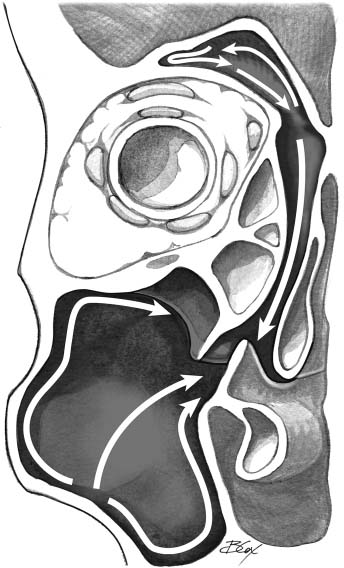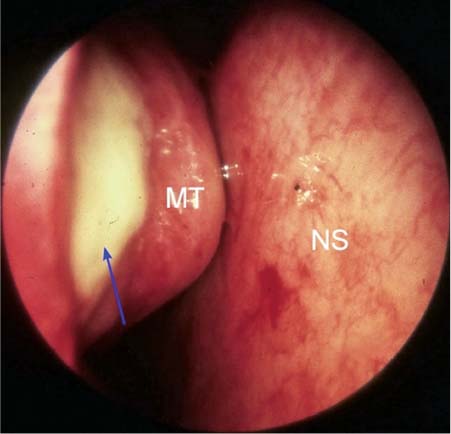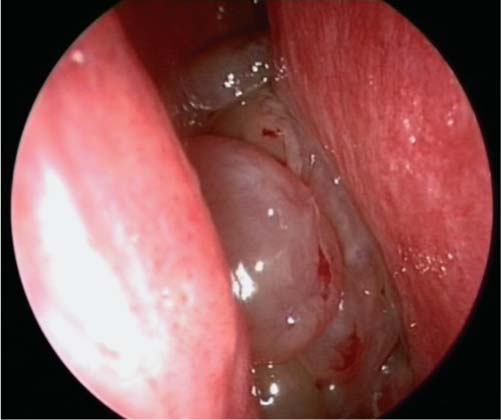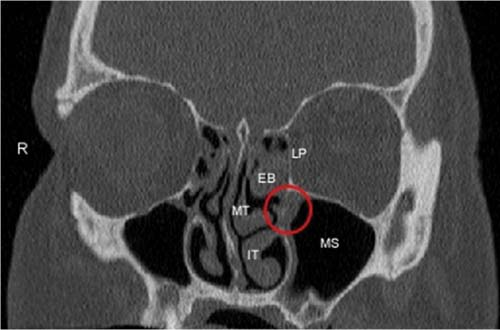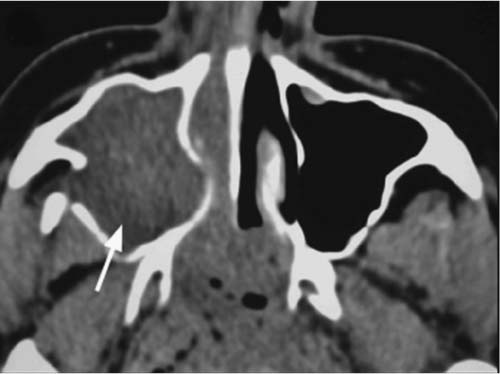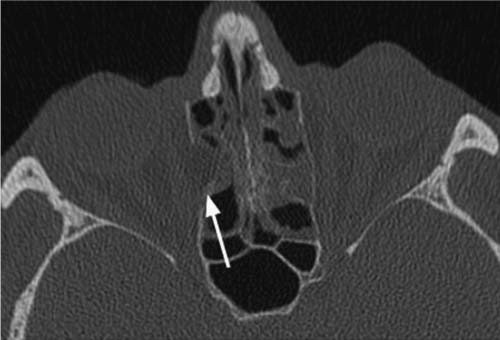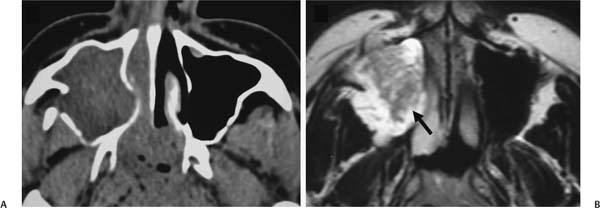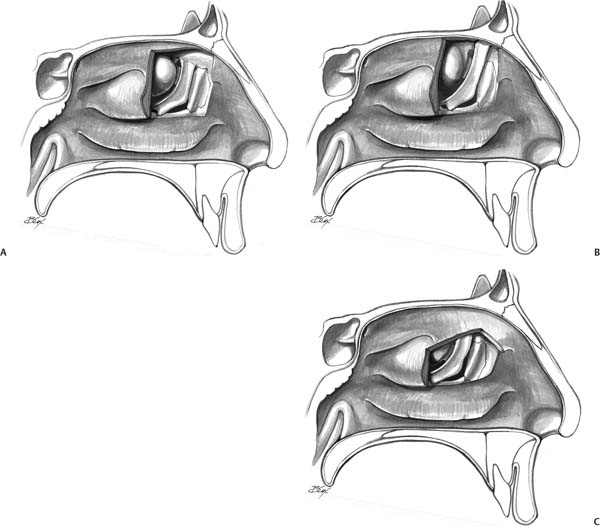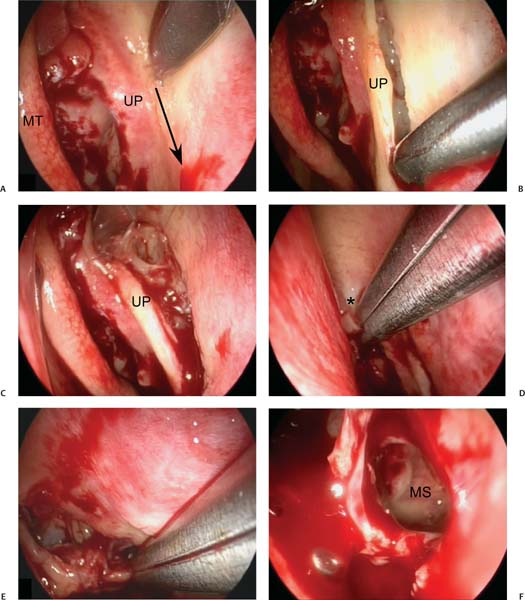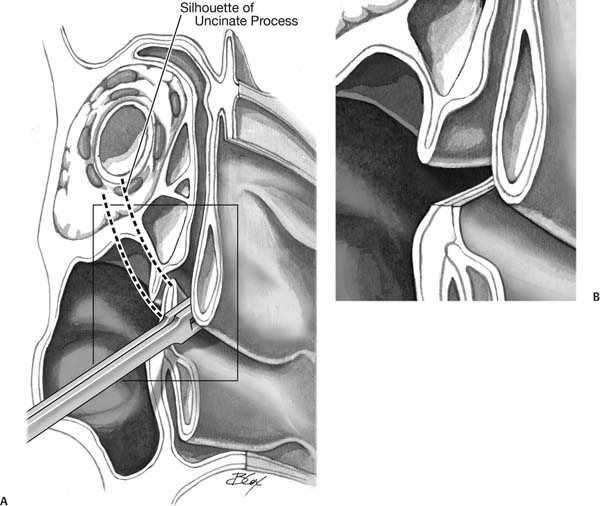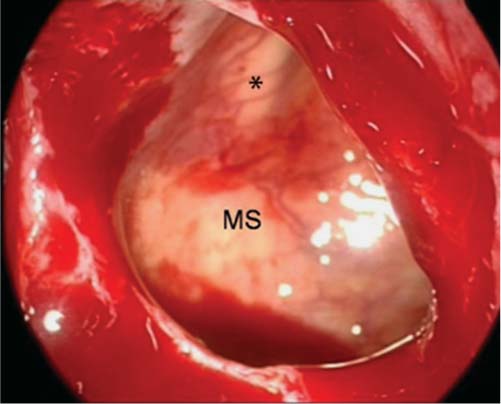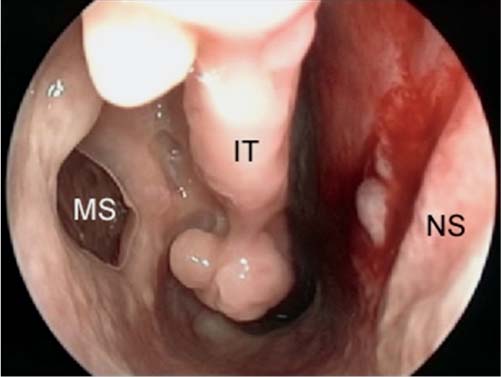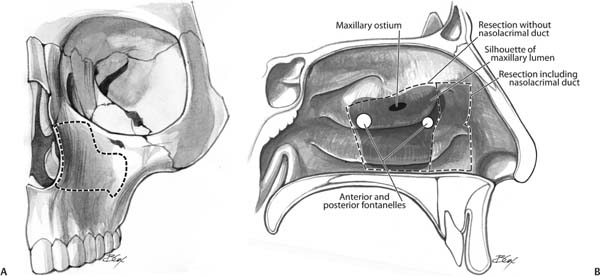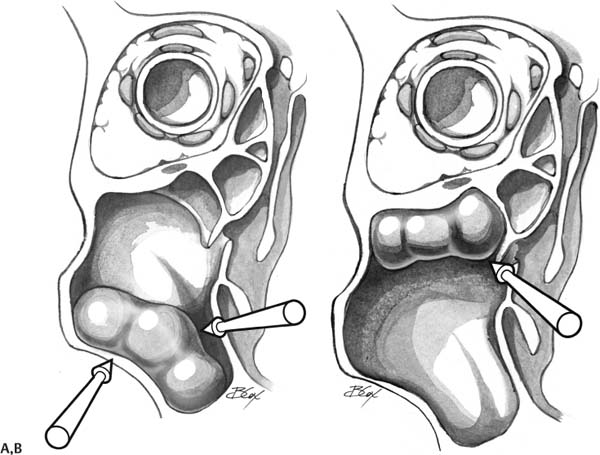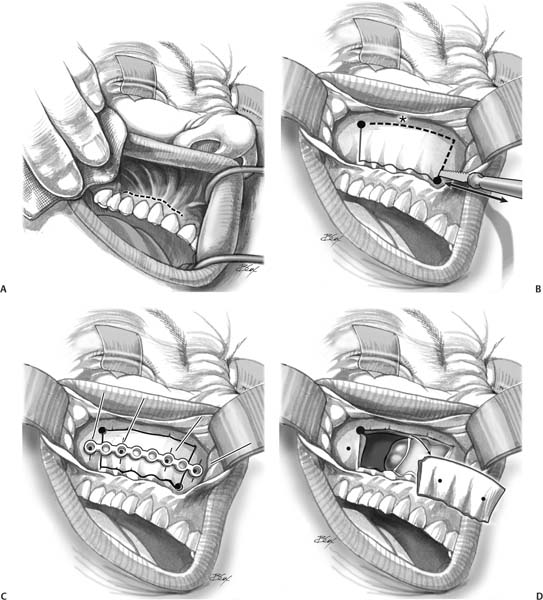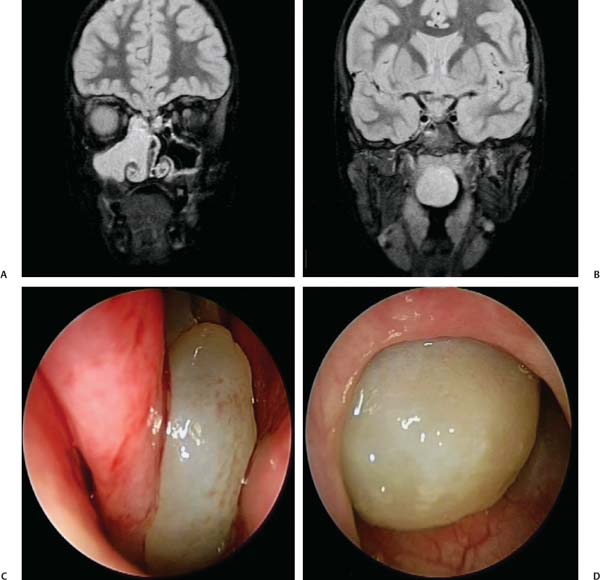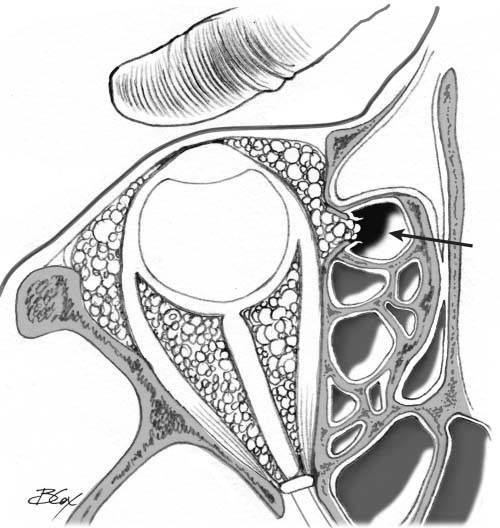11 Primary Endoscopic Surgery of the Maxillary Sinus More complex endonasal surgery of the paranasal sinuses was first performed at the beginning of the 20th century.1,2 Catastrophic complications during endonasal surgery, however, caused by primitive surgical conditions (e.g., using head lights and naked eyes) led to issues such as skull base injuries followed by meningitis, brain abscess, and/or encephalitis during that preantibiotic era. Early in the 20th century, Mosher therefore described endonasal ethmoid surgery as the most dangerous operation in all of surgery.3 Thus for many decades most surgeons favored the external approach for paranasal sinus surgery because it presented a lower risk for most dangerous complications. Cowper (1707) and Ziem (1886) were the first surgeons who treated the maxillary sinus through an opened alveole.4 Jourdain (1761) and Hartmann (1883) used the natural ostium of the maxillary sinus opening.5 The middle meatal antrostomy was first described by Siebenmann (1899).4 Lamorier (1743) and Desault (1789) published the canine fossa approach to the maxillary sinus. Claoué (1902), Lothrop (1898), and Mikulicz (1886) can be seen as the founders of the endonasal fenestration of the maxillary sinus.4,5 Caldwell (1893)6 and Luc (1897)7 described a large fenestration of the maxillary sinus through the canine fossa in combination with a drainage through the inferior nasal meatus. Denker (1905)8 developed a radical addition to the Caldwell–Luc procedure by resection of the piriform crest via a nasolabial incision. Fig. 11.1 Drawing of the ostiomeatal complex (OMC): physiologic secretion transport from frontal and maxillary sinus into the middle nasal meatus. A new era in sinus surgery began in the early 1970s with the development of different angled endoscopes based on the Hopkins rod lens technology and its use in the evaluation of the paranasal sinuses.9,10 Unlike Messerklinger, who investigated the anatomy and pathophysiology of the nose and its relationship to chronic sinusitis, Draf examined the different sinuses systematically. He was the first person to perform endoscopy of the frontal and the sphenoid sinus. Primarily, his goal was to develop solid indications for sinus surgery, thereby avoiding unnecessary, radical operations, especially because the imaging techniques were still poor at that time, offering only plain x-ray and at times, conventional tomography. Soon after, like Messerklinger he started to perform endoscopic treatment of inflammatory diseases. Nasal endoscopy with rigid instruments and computerized tomography (CT) of the paranasal sinuses enabled the surgeon to approach the ostiomeatal complex (OMC) more precisely. Based on Messerklinger’s studies, Stammberger and later Kennedy introduced a conservative type of sinus surgery to restore normal mucociliary flow in the region of the OMC, which they named functional endoscopic sinus surgery (FESS) (Fig. 11.1).11,12 Primary endoscopic maxillary sinus surgery (PEMSS) has many advantages over surgery using an external approach. PEMSS allows for • Intranasal incisions, which help to avoid vestibular fistula • Minimal intranasal and intrasinus trauma • Preservation of the bony framework and mucous membrane needed for restoration of normal mucociliary clearance The most common indications are • Chronic and/or recurrent maxillary sinusitis, unresponsive to prior medical treatment • Complicated acute maxillary sinusitis • Fungal maxillary sinusitis with formation of mycetoma • Antrochoanal polyp • Mucocele • Control of epistaxis • Resection of small benign tumors, especially inverted papillomas • Resection of selected malignant tumors Relative contraindications are • High-risk patients not suitable for general anesthesia (e.g., those with immunosuppressive conditions, advanced coronal heart disease, coagulopathy) • Extended tumors with involvement of the lateral and/or anteroinferior regions of the maxillary sinus • Untreated dentogenic maxillary sinusitis The most important aim of any surgical procedure is to relieve the patient’s symptoms. Not all symptoms of chronic sinusitis can be eliminated with surgical treatment. It is, therefore, vital to take the time to listen to the patient and to establish his or her main problems. A discussion is then required to make clear to the patient what can be achieved with surgery, and which symptoms are likely to be improved. It is important to remember that sinus surgery is not about treating a CT scan, but is part of the treatment regimen of a well-informed patient. In general, the history taken should include the following aspects. Patients frequently present their diagnosis to the surgeon, instead of describing their symptoms. Detailed questioning about the patient’s symptoms is required with concentration on the duration, time of onset, and any symptom-free intervals. The patients also should be asked if they suffer from the most common symptoms of chronic sinusitis. These include • Nasal obstruction • Hyposmia • Headache and location of pain • Recurrent facial swelling • Postnasal drip • Facial pressure Most patients who are referred for sinus surgery have been treated medically in the past. Many of them have received several antibiotic treatments in conjunction with systemic and/or topical corticosteroids. It is mandatory to ask all patients about any previous sinus surgery. The following questions require particular attention. • Has the patient undergone any antibiotic therapy? What were the effects? • Has the patient had local/systemic corticosteroid treatment? Was it in conjunction with antibiotic treatment? What was the duration of the treatment? • Is the patient on any other medication, particularly agents that can cause mucosal swelling as a side effect such as antihypertensive drugs? • Has the patient undergone any previous surgery? When? • Was the previous surgery successful and were there symptom-free intervals after the surgery? • Does the patient have Samter’s triad (polyps, asthma, aspirin intolerance)? Routine physical examination includes anterior rhinoscopy and rigid/flexible endoscopy. The anterior rhinoscopy, possibly with the examination microscope, gives the surgeon a first impression of the sinonasal condition. The following features should be noted from this examination. • Septal deviation • Color, texture, and turgor of the mucosa • Size and shape of the turbinates Endoscopic examination of the nasal cavity with rigid and flexible endoscopes is now the gold standard in the preoperative evaluation of chronic sinusitis. In our hospital, we prefer the flexible endoscope as it is well tolerated, even in children, and most patients do not even require local anesthesia. A zero- or 30-degree angled rigid endoscope also can be used to examine the nasal cavity. Before using a rigid endoscope, a mixture of topical anesthetic and a vasoconstrictor should be applied to the nasal mucosa. By displaying the endoscopic image on a television monitor, it is possible to demonstrate any pathology to the patient. The following anatomic structures should be evaluated routinely. • Relationship between the middle turbinate and the nasal septum • Paradoxical middle turbinate (a medially rather than laterally concave middle turbinate) • The presence of a concha bullosa (an air-filled, pneumatized middle turbinate) (Fig. 11.2) • The extent and size of any polyps (Fig. 11.3) Fig. 11.2 Endoscopic view of a pyocele (blue arrow) in a concha bullosa. NS, nasal septum; MT, middle turbinate. The evaluation of olfaction preoperatively is mandatory. Up to 45% of patients with chronic sinusitis complain of ol-factory dysfunction.13,14 Acoustic rhinometry is a noninvasive technique to measure the cross-sectional area of regions of the nasal airway. It has become more and more popular because it is rapid, noninvasive, and requires minimal cooperation from the subject. In case the patient does not feel improvement of airflow postoperatively, this investigation may be repeated as objective documentation. It is interesting to note that a patient’s subjective feeling about nasal airflow and the objective measurement do not always correlate. Rhinomanometry is an objective technique, in which changes in air pressure and the speed of air flow through the nasal cavities are measured during breathing. This allows the nasal resistance to airflow to be calculated. Computerized tomography (CT) is absolutely essential in planning endoscopic sinus surgery. In the event of a postoperative complication, a surgeon has little medicolegal defense if a preoperative CT scan was not performed. Scanning is best performed in the axial plane with additional coronal and sagittal reconstructed images. This minimizes any artifacts caused by dental fillings. Sagittal planes are very helpful in determining the extension of the frontal and sphenoid sinuses. Ideally, a CT scan should be done when the disease is quiescent and there is no acute inflammation of the sinuses. The extent of mucosal disease found at the time of surgery may differ from what is shown on the CT scan. In the majority of the cases, the findings are underestimated based on the CT scans.15 With the help of CT, the surgeon should evaluate extension and distribution of the disease and analyze important anatomic landmarks, variants, and any surgically hazardous anatomy. CT scans should be shown to the patients before surgery to explain the proposed surgery, and must be present in the operating room for the surgeon to review during surgery. Several authors have suggested a preoperative checklist for CT evaluation in functional endoscopic sinus surgery.16 For maxillary sinus surgery, we recommend the following CT work-up, ideally done with the radiologist on the day of surgery. Fig. 11.3 Extended polyposis with complete obstruction of the middle nasal meatus. • General overview of the paranasal sinuses in the coronal planes (Fig. 11.4) • Are the sides (right and left) correctly labeled? • Assess the ostiomeatal complex • Any unilateral maxillary sinus opacification? (Fig. 11.5) • Evaluation of important anatomic landmarks (axial and coronal planes) Fig. 11.4 Coronal computed tomography (CT) scan shows mild opacification of the OMC (red circle). MS, maxillary sinus; LP, lamina papyracea; EB, ethmoid bulla; MT, middle turbinate; IT, inferior turbinate. Fig. 11.5 Unilateral total opacification of the right maxillary sinus (arrow) in an inverted papilloma (axial computed tomography scan). In unilateral maxillary sinus opacification, a dentogenic sinusitis should be ruled out by a maxillofacial surgeon. If there is suspicion of an inverted papilloma, magnetic resonance imaging (MRI) is very helpful for further surgical planning (Fig. 11.7). Fig. 11.6 Axial computed tomography (CT) scan showing partial dehiscence of the lamina papyracea (arrow). Before surgery the patient should be informed about the advantages and possible complications of the surgery. It is mandatory also to mention possible catastrophic complications. The following points should be included in the preoperative conversation with the patient: • Failure, revision surgery • Alternative forms of treatment • Bleeding, infection, wound-healing disturbances • Injury to the optic nerve with possible reduced vision or blindness • Injury to the ocular muscles with possible permanent double vision • Injury of the dura with cerebrospinal fluid leaks, meningitis, encephalitis • Epiphora • Olfactory disturbances • Hypesthesia in the palate, teeth, or face • Burns to the upper lip in case of contact with a hot drill, although extremely rare Fig. 11.7 Inverted papilloma. (A) Axial computed tomography (CT) scan shows total opacification of the right maxillary sinus with involvement of the middle meatus and nasal cavity. In a CT scan, an inverted papilloma is not distinguishable from chronic sinusitis. (B) Axial T1-weighted magnetic resonance image (MRI) proves the existence of heterogeneous tumor tissue in the maxillary sinus (arrow), which is very specific for inverted papilloma. In endoscopic maxillary sinus surgery, the rigid fiberoptic nasal telescope provides superb visualization of the operative field.12,17 The zero-degree, 4-mm rigid telescope is used for the major part of the surgery. In children, one can use the 2.7-mm rigid endoscope. Most of the surgical field can be visualized with the zero-degree scope. In particular, beginners of endoscopic sinus surgery should perform almost the whole surgery with the zero-degree scope. As the angle of the telescope rises, so does the risk of disorientation. Therefore, the 30-, 45-, and 70-degree telescopes are only used for work in areas “around the corner” of the maxillary sinus. With a 30-degree endoscope, one is able to get an orientation over the middle meatal antrostomy, whereas the 45-degree endoscope is a very helpful instrument for judging the inferior region of the maxillary sinus. A camera is usually attached to the eyepiece of the endoscope and the endoscopic view is transmitted to a monitor. The surgeon can perform the surgery while looking through the endoscope or at the monitor, or a combination of both. Most surgeons nowadays look at the monitor, which allows for a more relaxed working position. Most commonly, a Freer elevator is used to medialize the middle turbinate and gain a better view of the uncinate process and ethmoid bulla. One also can use it for incision and removal of the uncinate process. Most surgeons prefer the sickle knife for this part of procedure. Blakesley forceps is suitable to remove mobilized polyps or tissue; the straight forceps is appropriate for removing the loose parts of the bone from the surgical area. Different types of curved suctions are used in the maxillary sinus. The backbiters (Rhinoforce Stammberger antrum Punch; Karl Storz Endoscopy-America, Inc., El Segundo, CA) are best for removal of the uncinate process. There are left, right, and intermediate backbiters. A major advantage is that one can take about three bites with these instruments before they need to be cleaned. They also can be used to widen the middle antrostomy in an anterior direction. PEMSS today is performed usually under general anesthesia in combination with local vasoconstrictor medications. As a local anesthetic, a combination of lidocaine 1% and 1/100,000 to 1/200,000 epinephrine is injected into the agger nasi and the uncinate process area. Furthermore, better vasoconstriction is achieved by additional placing of cotton swabs soaked in naphazolinhydrochlorid and cocaine 10% (maximal single dose rate of 2 mL) in the nasal cavity for 10 minutes. Time is spared if the injection is performed before the surgeon scrubs and the patient is sterile wrapped. Bleeding is a major concern during endonasal sinus surgery. In many cases, bleeding can be minimized with the support of specific anesthetic techniques. The anesthesiologist should be informed continuously about the actual bleeding condition, and should follow the surgery on a monitor. Intraoperative communication between the ear, nose, and throat (ENT) surgeon and the anesthesiologist is essential. If the comorbidities of the patient provides no contraindication, the anesthesiologist should intraoperatively aim at a mean arterial pressure of 60 mm Hg and a heartbeat rate of 50 to 60/min. Arterial hypotension will minimize hemodynamic causes for bleeding and, if required, can be achieved by intravenous administration of β-blockade or arterial vasodilators. The influence of various anesthetics on bleeding is under discussion. A total intravenous technique may have advantages with regard to bleeding on the microcirculatory level. If anesthetic techniques fail to provide a clear view of the surgical field, temporary application of cotton plugs soaked with adrenaline 1:1000 is useful.18 The risk of adrenaline-induced cardiac arrhythmias nowadays is almost negligible, when a total intravenous technique is used and the volatile anesthetic halothane is avoided. As described above the surgeon should first analyze the superior attachment and the anatomic variations of the uncinate process.19 In 70% of cases, the uncinate process is inserted into the lamina papyracea. In 30% of cases, it is attached to the skull base or to the middle turbinate (Fig. 11.8). Using a zero-degree scope, the uncinectomy or infundibulotomy is started by gentle medialization of the middle turbinate (Fig. 11.9). The next step consists of resection of the uncinate process and exposure of the ethmoid bulla. The uncinectomy can be performed in a posterior-to-anterior direction with a backbiter, or in an anterior-to-posterior direction with a sickle knife (Figs. 11.10A-F) or Freer elevator. The most cranial part of the uncinate process should be left intact preventing any mucosa damage and scar tissue formation around the frontal recess. The uncinate process is very thin and its incision should not be deeper than 1 mm to avoid any damage to the lamina papyracea. Once the uncinate process is incised and mobile (Figs. 11.10A,B,C), it can be removed with a straight forceps by a rotating and pulling maneuver at its upper and lower insertion (Figs. 11.10D,E). Remnants of the uncinate process can be removed with a backbiter anteriorly until the thick lacrimal crest is approached. Unlike the uncinate process, this bone usually is thick and there is a remarkable resistance. At this point, one should not go further anteriorly to avoid damage to the nasolacrimal duct (see Videos 11.1 and 11.2). Overall, the uncinectomy can be regarded as the first step for exposure of the ethmoid bulla and the ethmoid sinuses (Fig. 11.11). Fig. 11.8 Anatomic variations of the uncinate process according to Stammberger and Hawke.19 (A) Insertion into the lamina papyracea. The frontal sinus drains medially into the middle meatus. (B) Insertion into the skull base, or (C) insertion into the middle turbinate. In both these cases, the frontal sinus drains laterally into the ethmoidal infundibulum. Fig. 11.9 Intraoperative view with a 45-degree endoscope after medialization of the middle turbinate (MT). EB, ethmoid bulla; UP, uncinate process. Fig. 11.10 Endoscopic uncinectomy using a 45-degree angled telescope on the left side. (A,B) Incision of the uncinate process (UP) with a sickle knife in anterior to posterior technique (arrow). (C) Medialization of the uncinate process with a sickle knife. (D,E) Resection of cranial (*) and caudal attachment. (F) Endoscopic view into the maxillary sinus (MS) after uncinectomy. MT, middle turbinate. Fig. 11.11 (A) Resection of the uncinate process and exposure of the ethmoid bulla. (B) After removal of ethmoid bulla, anatomic orientation by identification of middle turbinate and lamina papyracea. In the case of concha bullosa, the head of the middle turbinate is incised with a sickle knife and the lateral portion removed with a through-cutting straight forceps. One should definitely preserve the medial portion and the superior attachment of the middle turbinate to prevent a floppy middle turbinate. In cases of septal deviation with limited access to the ostiomeatal complex (OMC), we first perform a septoplasty. If the middle nasal meatus is filled with polyps, we first remove the polyps to expose the uncinate process. This step can be performed with soft tissue shavers. In experienced hands, the uncinectomy can also be done with the shaver. Oscillation of the blade is realized by continuous suction, which permanently removes soft tissue, blood, and debris from the operative area. The soft tissue shavers are available in various sizes and shapes and have an oscillate speed of at least 1000 rpm. The maxillary sinus ostium can usually be visualized after the uncinate process has been removed. The ostium can be identified with a thin curved suction cannula. For further steps the 45-degree telescope is preferred. Enlargement of the natural ostium is managed posteriorly and inferiorly by extending its border to the posterior fontanel (Fig. 11.12). This step can be performed with a through-cutting and side-biting punch forceps. Dissections extended too far posteriorly may lead to arterial bleeding from the branches of the sphenopalatine artery. This bleeding can be managed with electrocautery. Extending dissections too far anteriorly should be avoided because this may cause damage to the nasolacrimal duct.20 Although its advantage has not been established, surgical connection of accessory ostia with the natural ostium is routinely performed to prevent circular transportation of secretions. With the help of the 45- and 70-degree telescope the maxillary sinus is examined and treated, when necessary. For removal of polyps in the inferior or lateral region of the maxillary sinus, we use the 90-degree curved Blakesley and/or the curved forceps after Heuwieser. In cases of huge polyposis of the maxillary sinus, we prefer to remove polyps with a curved soft tissue shaver. In case of intense bleeding with poor visualization of the operative field, the middle meatus is temporarily packed with cotton plugs as described above. With the help of the 70-degree telescope, the inferior and far lateral areas of the sinus can be inspected. Fig. 11.12 View into the left maxillary sinus (MS) with a 45-degree angled endoscope (* = infraorbital nerve) after uncinectomy and enlargement of the natural ostium. Also, endoscopic maxillary sinus surgery is performed usually as the first step in different pansinus operations. In cases of massive or recurrent polyposis with opacification of all sinuses (pansinusitis), we first perform a middle meatal antrostomy and proceed to a frontal sinus surgery type I, II, or III after Draf,21,22 depending upon the pathology (see Videos 11.3 and 11.4). Nowadays the indication for inferior meatal antrostomy is rare. Usually, we first perform a gentle conchotomy, corresponding to the planed window in the inferior medial wall of the maxillary sinus. It is useful to incise the inferior turbinate with a septal scissor parallel to the inferior margin in a way that a posteriorly pedicled flap is created. The length of this flap depends on the length of the planed window. The pedicle is cut with a cutting snare to reduce the bleeding to a minimum. Bipolar coagulation helps to provide meticulous hemostasis. Doing so, the result achieved is similar to those designed already by Claoue. The inferior portion of the medial maxillary sinus wall is opened with a 90-degree curved Blakesley. This primary window can be enlarged with a backbiter anteriorly (Fig. 11.13). With the popularity of FESS, the indication for an inferior antrostomy has decreased considerably. In our opinion, this type of surgery is indicated only in persistent or recurrent isolated maxillary sinusitis with cysts, polyps, or mycetomas due to dental pathology in the alveolar recess of the maxillary sinus. Fig. 11.13 Situs after inferior meatal antrostomy combined with conchotomy. IT, inferior turbinate; MS, maxillary sinus; NS, nasal septum. Endoscopic endonasal medial maxillectomy can be regarded as an extended endonasal approach to the maxillary sinus for resection of benign and, in special circumstances, malignant tumors. Details of this technique were published in 1910/1911 by Canfield in the United States23 and at the same time by Sturmann24 in Germany. It was later called the endonasal Denker operation. Interestingly enough, the nasolacrimal sac is not mentioned in either of the early publications. Recently, several authors reported on their experience with medial maxillectomy for removal of inverted papilloma (see below). The following areas may be resected in medial maxillectomy according to the patient’s needs: medially the complete medial wall of the maxillary sinus and the inferior turbinate; the anterior and posterior fontanel and maxillary process of the maxillary bone including the inferior part of the nasolacrimal drainage system if necessary. If indicated, the posterior maxillary sinus wall also can be removed. Usually, we first perform a wide middle meatal antrostomy with removing the medial maxillary wall cranially up to the level of the orbital floor. Fig. 11.14 (A) Extent of bony resection in endonasal Denker surgery with parts of piriform aperture, lacrimal bone, and anterior maxillary sinus wall. (B) Resection of the medial parts of the maxillary bone including the medial maxillary sinus wall and parts of the middle and inferior turbinate with preservation of the nasolacrimal duct. Resection can be widened including the nasolacrimal duct and a little area of the piriform aperture. In the next step, depending on the tumor extension, the medial wall is resected until the posterior margin of the tumor is reached. Bleeding from branches of the sphenopalatine artery can be stopped with electrocautery. Then, the medial maxillary sinus wall is resected anteriorly. In large tumors, the anterior dissection includes the lacrimal bone with the nasolacrimal duct. In this case, an endonasal endoscopic dacryocystorhinostomy is performed at the end of the medial maxillectomy. With this extended approach, the tumor margins can be visualized sufficiently to achieve a total removal. Diseased bone should be freed of pathology with a diamond burr. Tumors involving the mucosa of the posterior and/or anterior wall of the maxillary sinus may require a wider exposure of the entire sinus. In this case, the medial maxillectomy is combined with the resection of the medial portion of the anterior wall including the piriform crest. An endonasal Denker operation25 is the result. Figure 11.14 shows the resection area in this case. Mucoceles are slowly expanding epithelial-lined lesions containing mucus and have been found in all paranasal sinuses. They show an expanding behavior and can lead to pressure atrophy of the bone with extra sinonasal growth into the orbit and endocranium.26–28 Mucoceles are mostly found in the frontal sinus; maxillary sinus mucoceles are relatively rare and account for ~10% of all paranasal sinus mucoceles. Most cases of maxillary sinus mucoceles can be treated with an endonasal endoscopic approach. Usually the frontal wall of the mucocele sack is dissected and marsupialized (see Video 11.5). For mucoceles located too far lateral of the maxillary sinus, we prefer an osteoplastic maxillary sinus approach (Fig. 11.15). In one of the largest studies, Bockmühl et al29 analyzed the results of 290 mucoceles in 255 patients. Seventy-two patients had a mucocele of the maxillary sinus. In 42 mucoceles the etiology was previous surgery, most commonly a Caldwell–Luc operation. The majority of the mucoceles (69.3% n = 57) could be operated through an endonasal approach. The long-term results of this and other studies show that endonasal endoscopic surgery is an effective and safe approach for the majority of this type of pathology.27,30–32 Inverted papilloma (IP) accounts for ~70% of all sinonasal papillomas and from 0.5 to 4% of all neoplasms of the sinonasal tract.33 They are characterized by a high recurrence rate, a tendency for malignant transformation, and multicentric involvement. Traditionally, lateral rhinotomy or mid-facial degloving with en bloc tumor resection in combination with medial maxillectomy were used and are standard approaches today.34–37 However, there is currently a growing body of evidence to support endonasal endoscopic surgery in the resection of these tumors showing comparable rates of recurrence to an external approach.38–41 When properly indicated and planned, endonasal procedures can favorably compete with traditional external techniques in the surgical treatment of IP. Fig. 11.15 (A) Far laterally located maxillary sinus mucoceles might be contraindications for an exclusively endonasal endoscopic approach in contrast to (B) medial mucoceles. For IP of the maxillary sinus, the kind of operation varies in relation to the site of origin and the extent of the lesion. To choose the best surgical approach (i.e., to assess the endonasal endoscopic respectability), preoperative imaging is inalienable. Patient’s symptoms are more or less unspecific, and at the time of clinical examination it is almost impossible to distinguish IP from inflammatory polyps, even in unilateral distribution of nasal polyps. In the assessment of sinonasal expansile lesions, CT scan is generally considered the examination of choice. However, CT scanning cannot differentiate between retained secretion of inflamed mucosa and IP. According to Ojiri et al,42 this limitation can be overcome by using MRI, which, apart from differentiating neoplastic tissue from inflammatory changes, identifies a convoluted cerebriform pattern suggestive for IP on T2-weighted or enhanced T1-weighted sequences in ~80% of cases. In unilateral maxillary sinus opacification, preoperative MRI can be very helpful for further surgical planning and better informed consent (Fig. 11.7). Basically, we use a completely endonasal endoscopic resection or an endonasal procedure combined with an osteoplastic maxillary sinus (OMS) technique as described by Feldmann.43 In general, like mucoceles whenever the lesion originates far laterally in the maxillary sinus (Fig. 11.15), we tend to perform a combined procedure. All medially localized tumors are resected via an endonasal endoscopic procedure, which includes the medial maxillectomy or enlarged maxillary sinus technique indicated as an endonasal Denker operation.25 IPs that originate from the posterolateral, anterior, or inferior wall of the maxillary sinus are managed by a combined procedure of endoscopic and osteoplastic maxillary sinus operation (see Video 11.6). The OMS is started with a typical horizontal and slightly curved incision (~3 cm) at the canine fossa (Fig. 11.16). In the next step, the soft tissue is prepared in the subperiosteal plane and the anterior wall of maxillary sinus exposed. The infraorbital nerve is identified to prevent its damage during the bone dissection work. After that, the bone window is created with a special saw43 through the osteoplastic approach. An 8-hole plate, which is lightly curved, is put in place for drilling the burr holes. After this, the bony graft is removed and the lateral region of the maxillary sinus is bluntly freed from tumor using a surgical pad. The dissection work is continued until all tumor parts are removed from the maxillary sinus. In the final step, the bone graft that was temporarily taken out is replaced and fixed with two screws. If feasible, lesions are removed en bloc, but in large tumors the nasal portion of the mass is first debulked to focus subsequently on the most critical lateral areas, where dissection is always performed in the subperiosteal plane. Then drilling of the diseased-underlying bone is accomplished and frozen sections from surgical bed margins are taken to ensure surgical radicality and complete tumor removal. In a few cases, the additional use of the microscope can be helpful (see Video 11.7). During the last years, several series have been published reporting on the endonasal endoscopic management of IP; increasingly, this has been accepted as the surgical modality of choice for most IP.38–41,44–46 Our own study44 reported on 45 IPs of the maxillary sinus, which were treated by an endonasal and/or osteoplastic maxillary sinus approach. Fifty-three percent of the IPs could be removed via an endonasal approach. The remainder were resected either by combined (n = 16) or exclusively osteoplastic (n = 6) procedures (Fig. 11.17). During the follow-up period, ranging from 12 to 175 months (median 74 months) four recurrences (8.8%) were observed. Three tumors had been reoperated via a combined approach with one endonasal surgery. Hence, the recurrence rate for endonasal surgery was 2.2% compared with 6.6% after combined approach. The mean recurrence interval after endonasal surgery was 24 months in contrast to 101 months after combined approach. Fig. 11.16 Osteoplastic maxillary sinus approach for resection of inverted papilloma with extension into far lateral regions of the maxillary sinus. (A) Horizontal incision in the canine fossa. (B) Subperiosteal dissection, identification of the infraorbital nerve (*) and creation of a bony window by circumcising a bone graft with a jigsaw. (C) Fixation of a curved eight-hole plate to the bony window and marking of outer burr holes for later reattachment. (D) Temporary removal of the bone graft. Bone graft and blunt dissection (E) of the tumor with a surgical pad. (F) Refixation of the bone graft with two outer screws. Antrochoanal polyps (ACP) are benign lesions that are most commonly seen in children. This isolated polyp has its origin from the mucosa of the maxillary sinus and grows through the natural or accessory maxillary sinus ostium into the nasal cavity and can extend into choana and nasopharynx (Fig. 11.18). The major symptom is a unilateral nasal obstruction. Treatment of choice is primary endoscopic removal with resection of the basis in the maxillary sinus (see Video 11.8). Complete removal of the polyp’s base is mandatory to prevent a recurrence. Fig. 11.17 (A) Preoperative T2-weighted coronal magnetic resonance image presenting a large inverted papilloma that originated from the anterior lateral wall of the right maxillary sinus as well as the ethmoid. (B) Postoperative short tau inversion recovery (STIR) sequences after tumor resection via a combined technique including an osteoplastic maxillary sinus approach and endonasal medial maxillectomy (6 years postoperatively). No sign of recurrence. Fig. 11.18 Antrochoanal polyp. (A,B) Coronal T2-weighted magnetic resonance imaging (MRI) scan shows complete opacification of the right maxillary sinus and the middle meatus with extension into the nasopharynx. The polyp is hyperintense on T2-weighted MRI scans. (C) Endoscopic view of an antrochoanal polyp as a single large polyp in the middle meatus with (D) extension into the nasopharynx as seen transorally. The paranasal sinuses present a complex anatomy surrounded by important structures. Despite extensive surgical experience, complications still happen. In endoscopic maxillary sinus surgery, minor and rarely major complications as mentioned above may occur. For prevention of disastrous complications, the surgeon should follow certain guidelines and be aware of high-risk areas. Fracture or perforation of the lamina papyracea during sinus surgery can lead to periorbital emphysema and ecchymosis. Injury of the periorbit usually occurs during uncinectomy or during middle meatal antrostomy. In most cases, careful analysis of the CT scans can prevent this complication. It is mandatory to distinguish emphysema from retrobulbar hematoma because the first is observed, but the second frequently needs immediate intervention. In this case, a lateral canthotomy should be performed immediately to decrease the intraorbital pressure (see Video 11.9). Fig. 11.19 Bulb-pressing test: gentle pressure of the eye and simultaneous endonasal observation can be helpful to identify the lamina papyracea and possible injuries. In this case, orbital fat (arrow) can be identified intranasally by bulb pressing maneuver. Here is a summary of surgical recommendations to reduce complications in endoscopic maxillary sinus surgery: • Early identification of lamina papyracea and middle turbinate as the most important anatomic landmarks • Careful observation of the eye bulb throughout surgery by the surgeon and the assisting nurse • Bulb-pressing test after Draf and Stankiewicz47,48 can be helpful when there is suspicion of injury to the lamina papyracea (Fig. 11.19). • Always dissect laterally to the middle turbinate, never medially and superiorly • The middle meatal antrostomy should be performed just above the inferior turbinate and should not go further anteriorly than the head end of the middle turbinate • Identification of the infraorbital nerve before dissection of the bony window in osteoplastic maxillary sinus approach No standardized recommendations concerning postoperative care exist in the literature. The following general recommendations for postoperative treatment may be useful. Local aftercare of the surgical area by the ENT surgeon: • The most common indication of primary endoscopic maxillary sinus surgery is chronic rhinosinusitis unresponsive to conservative treatment. • The main aim of surgery is removing the pathology and maintaining the physiologic drainage of the sinuses into the ostiomeatal complex • Meticulous preoperative analysis of CT scans and individual anatomy is essential for adequate surgery. • Complete uncinectomy is mandatory to prevent recurrent maxillary sinusitis. • Early intraoperative identification of important anatomic landmarks is mandatory. • Endonasal endoscopic approach can be combined with osteoplastic technique for resection of tumors and other pathologies like mucoceles in the lateral area of the maxillary sinus.
 Indications and Contraindications
Indications and Contraindications
 Preoperative Evaluation
Preoperative Evaluation
The Patient’s History
Symptoms of the Present Illness
Past Medical and Surgical History
Physical Examination and Endoscopy
Imaging
 Uncinate process: shape, course, and site of insertion
Uncinate process: shape, course, and site of insertion
 Lamina papyracea: possible dehiscent areas (Fig. 11.6)
Lamina papyracea: possible dehiscent areas (Fig. 11.6)
 Middle turbinate: degree of pneumatization, presence of a concha bullosa, extension of resection in previous surgery
Middle turbinate: degree of pneumatization, presence of a concha bullosa, extension of resection in previous surgery
Informed Patient Consent
 Instrumentation
Instrumentation
 Surgical Techniques
Surgical Techniques
Anesthesia
Endoscopic Uncinectomy
Endoscopic Middle Meatal Antrostomy
Endoscopic Inferior Meatal Antrostomy
Endonasal Medial Maxillectomy
 Application of Endoscopic Maxillary Sinus Surgery for Special Pathologies
Application of Endoscopic Maxillary Sinus Surgery for Special Pathologies
Mucoceles
Inverted Papilloma
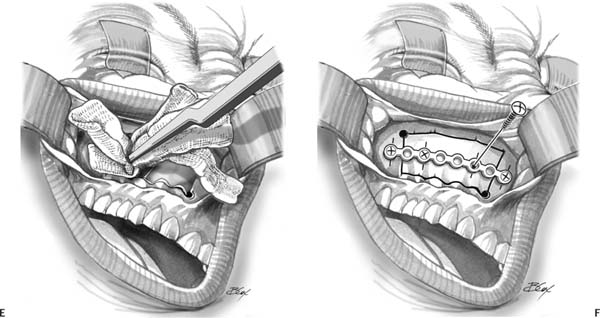
Antrochoanal Polyp
 Complications
Complications
 Postoperative Care
Postoperative Care
Primary Endoscopic Surgery of the Maxillary Sinus
Pearls
< div class='tao-gold-member'>Only gold members can continue reading. Log In or Register to continue

Full access? Get Clinical Tree


